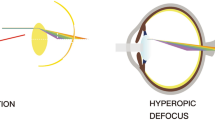Abstract
Astigmatism enables spatial, linear and directional discrimination. These faculties are demonstrated by astigmatic photographic experiments.
Comparative anatomic deductions lead to the assumption that the eyes of early mammals were astigmatic. Thereby these animals, lacking binocularity and accommodation, could achieve visual spatial information. This assumption is supported by the fact that features of astigmatic refraction, specially straight linearity, have been adopted by various intra-ocular structures, and by the neuronal structuralisation of receptive fields in the visual cortex of mammals.
Similar content being viewed by others
References
Barlow, H.B., Blakemore, C. & Pettigrew, J.D. The neural mechanism of binocular depth discrimination. J. Physiol. (London) 193: 327–342 (1967).
Barlow, H.B., Narasimhan, R & Rosenfeld, A. Visual pattern analysis in machines and animals. Science 177: 567 (1972).
Blakemore, C. & Cooper, G.F. Development of the brain depends on the visual environment. Nature 228: 477 (1970).
Brückner, R. Beiträge zur Biologie des Auges. Biol. Zentralbl. 80: 129–136 (1961).
Donders, F.C. On the Anomalies of Accommodation and Refraction of the eye. London (1864a). Abridged reprint, De Erven F. Bohn N.V., Haarlem, p. 204 (1962).
Donders, F.C. On the Anomalies of Accommodation and Refraction of the Eye. London (1864a). Abridged reprint, De Erven F. Bohn N.V., Haarlem, p. 207 (1864b).
Duke Elder, S. System of Ophthalmology, Vol. I, H. Kimpton, London, p. 472 (1958a).
Duke Elder, S. System of Ophthalmology, Vol. I, H. Kimpton, London, p. 491 (1958b).
Duke Elder, S. System of Ophthalmology, Vol. V, H. Kimpton, London, p. 278 (1970a).
Duke Elder, S. System of Ophthalmology, Vol. V, H. Kimpton, London, p. 275 (1970b).
Freeman R.D., Mitchell, D.E. & Millodot, M. A neural effect of partial visual deprivation in humans. Science 175: 1384 (1972).
von Helmholtz, H. Vorträge und Reden. Braunschweig 1: 286 (1903).
Hubel, D.H. & Wiesel, T.N. Receptive fields, binocular interaction and functional architecture in the cat's visual cortex. J. Physiol. (London) 160/1: 106–154 (1962).
Jerison. H.J. Evolution of the Brain and Intelligence, pp. 262–275, Academic Press (1973).
Jerison, H.J. Paleoneurology and the evolution of mind. Sc. Amer. 234/1: 90 (1976).
Johnson, G.L. Observations on the refraction and vision of the seal's eye. Proc. Zool. Soc. London, pp. 719–723 (1893).
Johnson, G.L. Ophthalmoscopic studies on the eyes of mammals. Phil. Trans. Roy. Soc. London 254: 207–220 (1968).
Kuffler, S.W. Neurones in the retina: organization, inhibition and excitation problems. Cold Spring Harb. Symp. Quant. Biol. 17: 281–292 (1952).
Lettvin, J.Y., Maturana, H.R., McCulloch, W.S. & Pitts, W.H. What the frog's eye tells the frog's brain. Proc. Inst. Radio Eng. N.Y. 47: 1940–1951 (1959).
Polyak, S. The Vertebrate Visual System, pp. 954, 968. The University of Chicago Press, Chicago and London (1957).
Rochon-Duvigneaud, A. Les Yeux et la Vision des Vertébrés, p. 585. Masson et Cie., Paris (1943).
Rodieck, R.W. The Vertebrate Retina. P. 360. W.H. Freeman & Co. (1973).
Romer, A.S. Vertebrate Paleontology. p. 202, University of Chicago Press, Chicago and London. (1966).
Stone J. & Freeman, R.B. Jr. Neurophysiology of Form Discrimination, in: Handbook of Sensory Physiology, Vol. VII, part 3/A, P. 167. Springer-Verlag, Berlin (1973).
Tansley, K.T. Vision in Vertebrates. Chapman & Hall, London, p. 60 (1965a).
Tansley, K.T. Vision in Vertebrates, Chapman & Hall, London, p. 72 (1965b).
Walls, G.L. The Vertebrate Eye and Its Adaptive Radiation. The Cranbrook Institute of Science, Bloomfield Hills, Michigan, p. 187 (1942a).
Walls, G.L. The Vertebrate Eye and Its Adaptive Radiation. The Cranbrook Institute of Science, Bloomfield Hills, Michigan, p. 287 (1942b).
Walls, G.L. The Vertebrate Eye and Its Adaptive Radiation. The Cranbrook Institute of Science, Bloomfield Hills, Michigan, p. 28 (1942c).
Walls, G.L. The Vertebrate Eye and Its Adaptive Radiation. The Cranbrook Institute of Science, Bloomfield Hills, Michigan, pp. 686–689 (1942d).
Walls, G L. The evolutionary history of eye movements. Vision Res. 2: 69–80 (1962).
Author information
Authors and Affiliations
Rights and permissions
About this article
Cite this article
Shilo, S. Astigmatism of the mammalian cornea: Evolutionary and perceptive significance. Doc Ophthalmol 44, 403–419 (1977). https://doi.org/10.1007/BF00230090
Issue Date:
DOI: https://doi.org/10.1007/BF00230090




